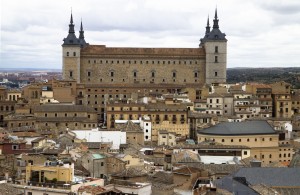Study in Toledo, Spain
Study in Toledo, Spain

Home to a mixture of cultures throughout its long and storied history, Toledo, Spain features a unique combination of historical elements; the city’s strong Arabic, Jewish, and Christian elements have not entirely eclipsed the older Roman and Visigoth eras, which are still visible today in some of its medieval architecture.
The hilltop city of Toledo is a municipality located in central Spain, approximately 70 kilometers south of Madrid, the nation’s capital. It is the capital of the province of Toledo and the autonomous community of Castile–La Mancha. It was honored as a World Heritage Site by the United Nation’s UNESCO body in 1986 for its far-reaching cultural and monumental heritage and the historical co-existence of Christian, Muslim and Jewish cultures.
Toledo has been dubbed the “Imperial City," for having been the main setting of the court of Charles I, and also called the "City of the Three Cultures," having been influenced by a historical cooperation of Christians, Muslims and Jews. In 1085, the city fell to Alfonso VI of Castile as the first major city in the Christian Reconquista. Toledo has a storied tradition in the production of bladed weapons, which are now popular souvenirs sold throughout the city.
Notable people who were born or have lived in Toledo include Al-Zarqali, Garcilaso de la Vega, Eleanor of Toledo, Alfonso X and El Greco. It was also the place of important historic events such as the Visigothic Councils of Toledo. As of 2012, the city has a population of 84,019 and an area of approximately 90 square miles (232.1 km2).
Those planning to visit the beautiful city of Toledo should set aside plenty of time for sightseeing, as the town is home to a wealth of noteworthy sights and attractions. These include (but are certainly not limited to) the world-famous Alcazar, the Alcantara Bridge, and the Cristo de la Luz Mosque.
The Alcazar is an enormous stone fort and palace located on the highest point of Toledo. The emperor Carlos V ordered the building of the Alcazar, to be used as his royal residence. The first architect was the Spaniard Alonso de Covarrubias, who initiated construction in 1545, choosing the Renaissance style that was popular in the day. The palace was never lived in by the Spanish kings; before it was finished Madrid had replaced Toledo as the capital of the country. The Alcazar became famous during the Spanish Civil War when, in 1936, the Republican forces laid siege to—and nearly destroyed—it. The palace was reconstructed in 1940, and in 1961 a monument, created by Juan de Avalos, was inaugurated. After that it became the home of the National Army Museum.
The Alcantara Bridge spans the Tajo River andis one of the most noteworthy bridges in Toledo. During the Middle Ages, it was the only bridge leading to town and therefore very strategic from a defensive standpoint. It was built during Roman times but was heavily damaged in the 10th century and later rebuilt. The bridge once featured two large defensive towers on either side; however, a Baroque triumphal arch replaced the West Tower in 1721 because of its decaying state. The other tower has a double door and portcullis, which were added in 1217. The bridge was declared a National Monument in 1921.
Finally, the Cristo de la Luz Mosque, which is located on the street of the same name, is perhaps the most important structure representing Toledo’s former Muslim roots. The mosque was built in 980 by the Moorish architect Musa ibn Ali, as shown by a Kufic inscription on the main facade. The building has a square base and represents the most important examples of Islamic art in Toledo. Inside the building, the three naves are split between nine spaces, each covered with ribbed vaults that vary in nature. There are four exterior columns, around which are twelve horseshoe arches. Although once a fully-functioning Muslim mosque, the building was repurposed in the 12th century as a place for Christian worship.

